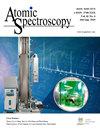Electron Probe Microanalysis In Geosciences: Analytical Procedures And Recent Advances
IF 2.3
2区 化学
Q1 SPECTROSCOPY
引用次数: 12
Abstract
Electron probe microanalysis (EPMA) is an in-situ and non-destructive analytical technique with high spatial resolution and an increasingly important analysis tool in materials science and geosciences. This study summarizes the principles and functions of EPMA, and the problems and difficulties, along with the recent advances in quantitative analysis of EPMA. A routine EPMA procedure includes preparing samples, setting analytical conditions, acquiring data, and evaluating results. Caution is required in all steps to obtain high-quality analytical results. The problems and difficulties commonly encountered in EPMA are discussed and the corresponding measures and solutions required to resolve them are proposed. Specific analytical methods are suggested to make accurate analysis of some specific minerals. We also summarized the challenges and solutions in light element analysis, trace element analysis, EPMA U-Th-Pb total dating, combined analysis with wavelengthand energy-dispersive X-ray spectroscopy, submicron spatial resolution analysis at low accelerating voltages, iron oxidation state analysis, and standard reference materials.地球科学中的电子探针微分析:分析方法和最新进展
电子探针微分析(EPMA)是一种具有高空间分辨率的原位无损分析技术,是材料科学和地学领域日益重要的分析工具。本研究概述了电子探针的原理、功能、存在的问题和困难,以及电子探针定量分析的最新进展。常规EPMA程序包括制备样品、设置分析条件、获取数据和评估结果。在获得高质量分析结果的所有步骤中都需要谨慎。讨论了EPMA中常见的问题和困难,并提出了解决这些问题的措施和解决方案。为了对某些特定矿物进行准确的分析,提出了具体的分析方法。我们还总结了轻元素分析、微量元素分析、EPMA U-Th-Pb全测年、波长和能量色散X射线光谱的组合分析、低加速电压下的亚微米空间分辨率分析、铁氧化态分析和标准参考材料方面的挑战和解决方案。
本文章由计算机程序翻译,如有差异,请以英文原文为准。
求助全文
约1分钟内获得全文
求助全文
来源期刊

Atomic Spectroscopy
物理-光谱学
CiteScore
5.30
自引率
14.70%
发文量
42
审稿时长
4.5 months
期刊介绍:
The ATOMIC SPECTROSCOPY is a peer-reviewed international journal started in 1962 by Dr. Walter Slavin and now is published by Atomic Spectroscopy Press Limited (ASPL). It is intended for the rapid publication of both original articles and review articles in the fields of AAS, AFS, ICP-OES, ICP-MS, GD-MS, TIMS, SIMS, AMS, LIBS, XRF and related techniques. Manuscripts dealing with (i) instrumentation & fundamentals, (ii) methodology development & applications, and (iii) standard reference materials (SRMs) development can be submitted for publication.
 求助内容:
求助内容: 应助结果提醒方式:
应助结果提醒方式:


